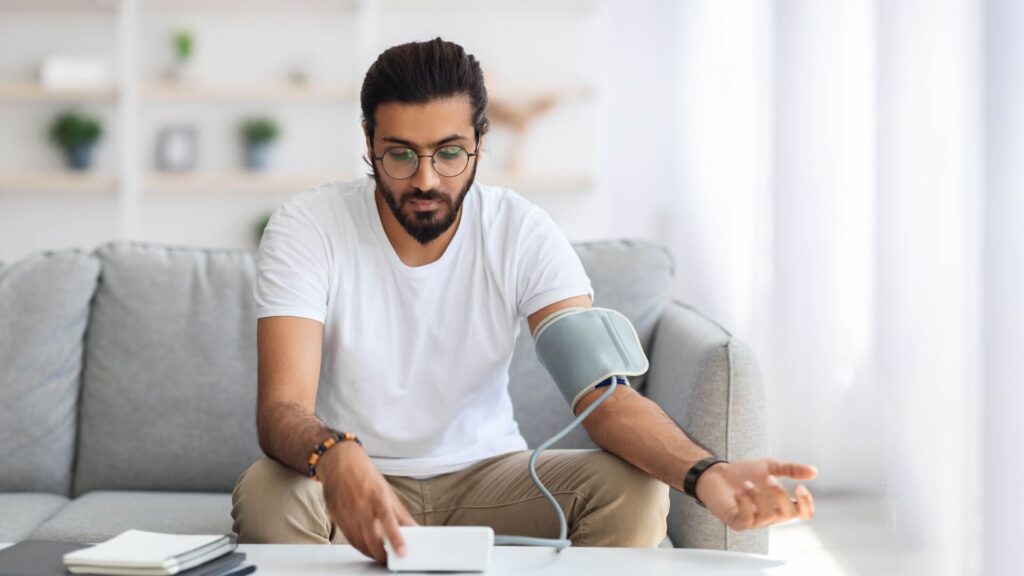
New ACC/AHA High Blood Pressure Guidelines have been recently issued. Blood pressure categories in
the new guideline are as follows:
Normal: Less than 120/80 mm Hg
Elevated: Systolic between 120-129 and diastolic less than 80
Stage 1: Systolic between 130-139 or diastolic between 80-89
Stage 2: Systolic at least 140 or diastolic at least 90 mm Hg
Hypertensive crisis: Systolic over 180 and/or diastolic over 120, with patients needing prompt changes in
medication if there are no other indications of problems, or immediate hospitalization if there are signs
of organ damage.
What is Hypertensive Retinopathy?
The retina is the tissue layer located at the back of your eye. This layer transforms light into nerve
signals that are then transmitted to the brain for interpretation. When your blood pressure is too high,
the retina’s blood vessel walls may thicken. This may cause your blood vessels to become narrow, which
then restricts blood from reaching the retina.
In sustained systemic hypertension, there is vascular leakage due to disruption of the blood-retinal
barrier. Hypertensive retinopathy shows features of narrowing (Vasoconstriction), involutional sclerosis
(arteriosclerosis) and leakage (hemorrhage, oedema and hard exudates).
Over time, high blood pressure can cause damage to the retina’s blood vessels, limit the retina’s
function, and put pressure on the optic nerve, causing vision problems. This condition is called
hypertensive retinopathy (HR).
CLASSIFICATION
• Hypertension may be primary or essential, for which there is no detectable cause. Usually, the
average blood pressure measures greater than 140 mm Hg systolic or 90 mm Hg diastolic on at least two
subsequent visits.
• Secondary hypertension may be caused by an underlying disease such as:
Primary hyperaldosteronism
Cushing’s syndrome
Phaeochromocytoma
Renal vascular or renal parenchymal disease
Coarctation of aorta
Hyperthyroidism
Hyperparathyroidism
• Malignant hypertension is a rare condition that causes blood pressure to increase suddenly and
rapidly elevation of blood pressure greater than 200 mg Hg systolic 140 mm Hg diastolic, interfering with
vision along with other systemic findings. This is a potentially life-threatening condition that needs
emergency treatment and admission to hospital.
RISK FACTORS
• A lack of physical activity
• Being overweight
• Eating too much salt
• A stressful lifestyle
• Prolonged high blood pressure
• Diabetes
• Smoking
• High cholesterol
• Heavy alcohol consumption
Major risk factor for essential hypertension is the severity of hypertension.
SYMPTOMS AND SIGNS
Patients with chronic hypertensive retinopathy are usually asymptomatic. However, the following are a
few ways that the ailment can be distinguished –
• Retinal changes include irregularity and narrowing of arteries, narrowing of veins at AV
crossings/nicking, blot retinal haemorrhages, cotton wool spots – fluffy white lesions on the retina due
to nerve fibre layer damage. Malignant hypertension is generally symptomatic, involving retina, choroid,
and the optic nerve. Symptoms include reduced vision, photopsia, and double vision accompanied by
headaches
• Retinal findings include linear retinal haemorrhages, macular edema, focal arteriolar narrowing,
cystoid macular edema, lipid deposits and cotton wool spots
• Choroidal findings include elschings pots due to choriocapillary occlusion and subretinal fluid
accumulation
• Optic nerve shows disc edema with adjacent edema and reduced vision
Few patients may present with neurological field loss due to stroke/ CVA secondary to Hypertension.
SYSTEMIC ASSOCIATION
Patients with borderline hypertension are at increased risk of coronary artery disease, end-stage renal
diseases – doubled; and run a greater risk for stroke or peripheral vascular disease.
Patients with malignant hypertension are at an increased risk of heart failure, MI, stroke, and renal
failure.
SYSTEMIC HYPERTENSION MAY SHOW OTHER OCULAR MANIFESTATIONS SUCH AS – Retinal artery
occlusion.
Retinal artery occlusion occurs when the arteries that carry blood to the retina become blocked by
blood clots. When this happens, the retina doesn’t get enough oxygen or blood. This results in a gradual
vision loss.
Retinal vein occlusion – Retinal vein occlusion occurs when the veins that carry blood away from the
retina become blocked by blood clots.
Retinal arterial macroaneurysm – Retinal arterial macroaneurysms are acquired, focal dilations of retinal
arterial branches (mostly second-order retinal arterioles) that can be classified as hemorrhagic or
exudative.
Ischaemic optic neuropathy – Ischemic optic neuropathy occurs when high blood pressure blocks off
normal blood flow in the eyes, damaging the optic nerve.
DIAGNOSIS
Diagnosis of hypertensive retinopathy is based on the presence of systemic hypertension and
examination of the retina (by an eye specialist) after dilating the pupil either with direct or indirect
ophthalmoscopy and a slit-lamp examination with 90 d lens.
Other tests like fluorescein angiopraphy are required in malignant hypertension to ascertain the
diagnosis or to rule out other similar conditions.
Treatment
Systemic hypertension should be controlled as a primary measure to avoid the occurrence of
Hypertensive retinopathy. Change in lifestyle with reduction of general risk factors like salt restriction,
avoidance of tobacco, regular exercise and walking and alcohol cessation help in controlling
hypertension.
Hypertensive retinopathy with vision-threatening complication, like retinal oedema, may be treated
with laser therapy or intravitreal injection of vascular endothelial growth factor (VEGF) drugs, under the
supervision of a qualified retinal specialist
Management of malignant hypertension is done by physician-drugs like sodium nitroprusside, calcium
channel blockers, ace inhibitors, nitroglycerin etc. However, a very rapid decline in BP can cause damage
to the brain, optic nerve and retina causing permanent damage so it should be done with caution.
Tips to Prevent Hypertensive Retinopathy
• Take your blood pressure medication regularly
• Get regular exercise
• Eat a balanced diet
• Avoid smoking, alcohol, and a diet high in cholesterol
• Get regular medical exams to ensure that your blood pressure readings are normal